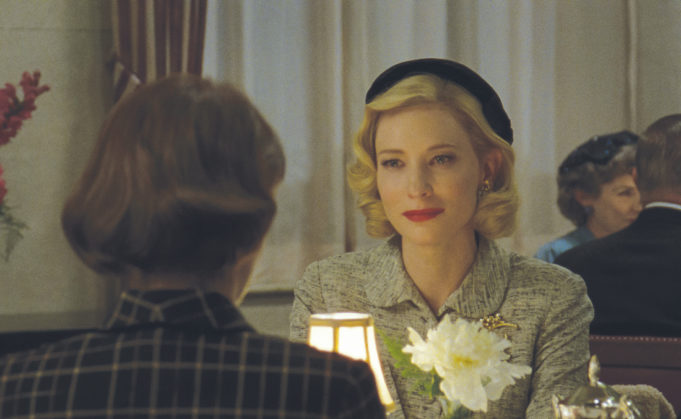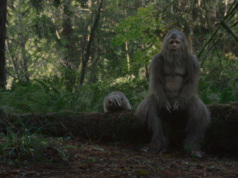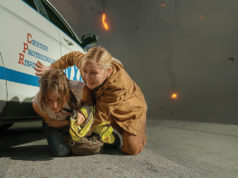There’s a proud tradition of gay male film directors who make their best movies about women: George Cukor, Rainer Werner Fassbinder, Pedro Almodóvar, François Ozon. (Xavier Dolan is next in line.) Todd Haynes belongs among these greats, and it makes him the perfect choice to direct Carol, a lesbian romance adapted from a novel by Patricia Highsmith. Strangely, this acclaimed movie that originated with a Fort Worth author is playing in Arlington and Southlake (and Grapevine as of this week) before it gets to our city, but this rapturous love story is easily worth the trip.
It begins in New York City in December 1952, as Therese Belivet (Rooney Mara) takes a seasonal temp job at a department store selling toys. Though she has a boyfriend (Jake Lacy), Therese is lightning-struck when wealthy New Jersey housewife Carol Aird (Cate Blanchett) glides up to her counter looking for a Christmas gift for her 4-year-old daughter. Carol’s forgotten pair of gloves gives them an excuse to meet up again and eventually fall for each other, but their love is imperiled by Harge (Kyle Chandler), the husband whom Carol is in the process of divorcing and who is just pissed enough to use their daughter against her in their divorce proceedings.
This is a movie where everything has to be decoded. This love truly dares not speak its name: No one in the entire film says the words “lesbian,” “gay,” or “homosexual.” Carol’s divorce lawyer (Kevin Crowley) announces he’s going to talk plainly with her and then proceeds to do the exact opposite. People can’t call Therese and Carol’s relationship what it is, and this makes every gesture and line pregnant with meaning, whether it’s Harge asking Therese in threatening fashion,“How do you know my wife?” or Carol’s ex Abby (Sarah Paulson) suddenly bringing up Carol’s new love: “She’s young. Tell me you know what you’re doing.” In this highly repressed atmosphere, it feels earth-shaking when Therese impulsively takes Carol’s hand over the table at a diner.
You need sensitively attuned actors for material like this, and Haynes gets the right people. Chandler finds layers of grief in a potentially detestable part, while Paulson is steely and wistful in hers — you sense that Abby would jump into Carol’s arms if she ever said, “I want you back.” Blanchett brings a velvety touch to a character who puts up a cool, elegant façade as a way to survive, and she lets us see the façade fray, most memorably in a magnificent late speech when Carol falls on her sword at a custody hearing to avoid an all-out war that will damage her child.
Still, you see why Mara won the best actress prize at Cannes over Blanchett and everyone else. Playing a young woman ambushed by desires that she doesn’t even have a framework for understanding, she always shows the pull of attraction to this sophisticated older woman even as she becomes aware of how dangerous it is. Carol eventually leaves Therese out of fear of never getting to see her daughter again, and just the way Mara sits on a motel bed tells you how crushed Therese is. The movie’s title notwithstanding, this is really Therese’s story of coming into her own, and all the fears and wants that come with that are visible in Mara.
As with all Todd Haynes’ other movies, every production element here expresses his vision. Haynes’ other 1950s-set romance, Far From Heaven, adopted a hypersaturated, operatic look rooted in its characters’ forbidden romance. Here, his cinematographer Ed Lachman and production designer Judy Becker go in for a more restrained color palette — the department store that employs Therese looks properly joyless. Fashionistas will gawk at Carol’s haute couture dresses, but the real story in Sandy Powell’s costumes is how Therese’s clothes go from shapeless to sharp and professional.
A student of film theory, Haynes knows that movies throughout history have assumed a male point of view. He counters that by constantly emphasizing and questioning how the women are looked at and how they look at things. That’s why Therese is an aspiring photographer here; the character in the novel wanted to design theater sets. She embarrasses herself during her first meeting with Carol because she’s so busy staring at this woman. At another point, Therese spots two pantsuit-wearing butch lesbians in a record store and scurries away, no doubt wondering whether she’s really like them. This movie is modeled on 1950s Hollywood romances, but its insistently female point of view helps it chafe against that model and point out how those older films overlooked characters like the ones here.
The austerity of Carol reminds you of Brokeback Mountain, that other great gay romance set in a hostile time. However, the fact that the seasons change from winter to spring here (as opposed to fall to winter in Far From Heaven) clues you into this movie’s more hopeful ending. These women’s courage burns through the movie’s surface chill, and their ultimate resolve to try to make a life together whatever the difficulties makes this a heartening romance for our time as well as theirs.
[box_info]Carol
Starring Cate Blanchett and Rooney Mara. Directed by Todd Haynes. Written by Phyllis Nagy, based on Patricia Highsmith’s novel. Rated R.[/box_info]












